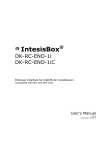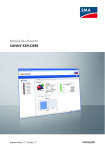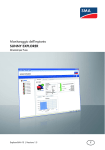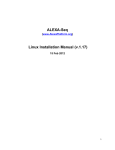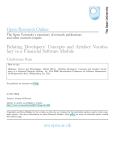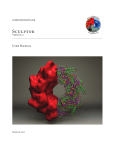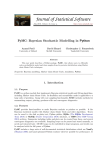Download HDF5 Indexing and Searching Research of the Indexing
Transcript
HDF5 Indexing and Searching
Research of the Indexing and Searching possibilities of
HDF5 files
Bachelor in de toegepaste informatica
Niels Van Rooy
Academiejaar 2013-2014
Campus Geel, Kleinhoefstraat 4, BE-2440 Geel
3
PREFACE
In the last year bachelor in Applied Computer Sciences, all students do an internship of
13 weeks. We had many options but only few were appealing to me. I eventually chose
to do my internship at Janssen Pharmaceuticals. This internship interested me because
of the challenges it provided. This documents will describe the progress I made during
my internship.
My personal goal during my internship and thesis was to be challenged and to gain
knowledge. Looking back to the complete experience, my expectations were satisfied. I
had the honor of having an expert Java developer as a colleague. He always took the
time and effort to answer every question I had. Due to the complexity of my
assignment, I couldn’t have completed this without him. I would like to give special
thanks to this colleague, Frederick Michielssen, for sharing all his knowledge with me.
Further, I would like to thank Frans Cornelissen, my supervisor at Janssen, for
providing me with an amazing internship, believing in my capabilities and allowing me
to research some very interesting topics. His knowledge and guidance was crucial in
this internship. I would like to thank my school, Thomas More Kempen and Janssen
Pharmaceuticals for providing me this opportunity. I would like to thank my college
tutor Christine Smeets for her guidance through this internship. Finally I would like to
thank all my colleagues, Frederick Michielssen, Jan Dockx and Vincent Tanghe for their
support.
4
SUMMARY
This document describes the work and research I have performed during my internship
at Janssen Pharmaceuticals
The Research and Development (R&D) department at Janssen Pharmaceuticals works
hard to discover new medicines. This process is supported by the R&D IT department
which provides the researchers with all necessary IT solutions. All the tests that are
being done have to be analyzed as efficient as possible. Phaedra, the project I worked
on, is a High Content Screening tool developed by the IT department to support their
scientists.
Phaedra reaches the release of its third version. This means that a lot of new features
have been developed which needed to be documented. This documentation had to
cover all the new functionalities of Phaedra and needed to be integrated within
Phaedra. DITA is a documentation technique which enables you to create an advanced
technical documentation. I had to implement DITA into Phaedra and write a good and
strong technical documentation. The implementation of DITA succeeded and the new
documentation was developed.
The third release of Phaedra can still use some additional functionalities. One of these
functionalities is the search option for cellular data. Cellular data in Phaedra is stored in
the scientific data format HDF5. This data format does not provide search
functionalities, because of the large amount of cellular data in Phaedra. A good indexing
and searching technique is required. I was responsible for the task to research the
HDF5 indexing and searching possibilities. The best possible solutions were researched
and the test cases for these solutions were made.
5
TABLE OF CONTENTS
PREFACE .......................................................................................................... 3
SUMMARY ......................................................................................................... 4
TABLE OF CONTENTS ........................................................................................ 5
LIST OF FIGURES ............................................................................................. 7
INTRODUCTION................................................................................................ 8
1
JANSSEN PHARMACEUTICALS ............................................................ 9
1.1
1.2
1.3
1.4
About Janssen Pharmaceuticals ......................................................... 9
Dr. Paul Janssen ................................................................................ 9
About Johnson & Johnson ................................................................ 10
Research & Development Department ............................................. 10
2
PROJECT PLAN ................................................................................. 11
2.1
2.2
2.3
2.4
2.4.1
2.4.2
2.5
2.6
Context and Background of the Internship ...................................... 11
Project goals .................................................................................... 11
Business Case .................................................................................. 12
Project plan ..................................................................................... 12
Phaedra documentation ........................................................................ 12
HDF5 Indexing & Searching ................................................................... 13
Primary Target Group and Other Stakeholders ................................. 13
Information and Reporting .............................................................. 13
3
SOFTWARE AND PROGRAMMING LANGUAGES .................................. 14
3.1
3.1.1
3.1.2
3.1.3
3.1.4
3.1.5
3.2
3.2.1
3.2.2
3.2.3
Software .......................................................................................... 14
Eclipse ................................................................................................ 14
DITAworks .......................................................................................... 15
Microsoft Visual Studio.......................................................................... 17
HDFView ............................................................................................. 18
Cygwin ............................................................................................... 19
Programming Languages ................................................................. 20
Java ................................................................................................... 20
C++ ................................................................................................... 20
Python ................................................................................................ 20
4
PHAEDRA CONCEPTS ........................................................................ 21
4.1
4.2
Phaedra ........................................................................................... 21
Main Entity Definitions ..................................................................... 22
5
PHAEDRA DOCUMENTATION ............................................................ 27
5.1
5.2
5.3
5.4
5.5
Documentation development ........................................................... 27
Live Actions ..................................................................................... 30
Context-Sensitive Help ..................................................................... 30
Implementation ............................................................................... 31
Result .............................................................................................. 31
6
HDF5 INDEXING AND SEARCHING ................................................... 32
6.1
6.2
6.2.1
6.2.2
6.2.3
6.2.4
6.2.5
Limitations with the current HDF5 searching possibilities ............... 32
Lucene Core ..................................................................................... 33
About Lucene ...................................................................................... 33
Lucene Implementation Analysis ............................................................ 35
Lucene in Phaedra ................................................................................ 36
Advantages vs. Disadvantages of Lucene ................................................ 37
Recommendation ................................................................................. 37
6
6.3
6.3.1
6.3.2
6.3.3
Pytables ........................................................................................... 37
About Pytables..................................................................................... 38
Pytables Implementation Analysis .......................................................... 39
Pytables in Phaedra .............................................................................. 39
6.3.3.1
6.3.3.2
6.3.3.3
Searching ...................................................................................................................... 39
Scalability ...................................................................................................................... 39
Solutions to the standard shortcomings ............................................................................. 39
7
TESTING POSSIBLE SOLUTIONS....................................................... 45
7.1
7.1.1
7.1.2
7.1.3
7.1.4
7.2
7.2.1
7.2.2
7.2.3
7.2.4
7.2.5
7.2.6
7.2.7
7.2.8
7.2.9
Lucene Test Case ............................................................................. 45
Lucene demo implementation ................................................................ 45
Basic HDF5 file search with Lucene. ........................................................ 45
Optimizing the documenting stage ......................................................... 46
Conclusion .......................................................................................... 47
FastQuery Test Case ........................................................................ 48
Compiling FastQuery ............................................................................ 48
FastQuery Command-Line Tests ............................................................. 49
Java test case ...................................................................................... 50
Issue: Query returns amount of hits ....................................................... 51
Issue: FastQuery crashes on specific queries ........................................... 51
Issue: FastQuery initializes all available datasets ..................................... 52
Issue: Alternative for the .exe file .......................................................... 52
Issue: Index file size ............................................................................ 53
Recommendation ................................................................................. 54
6.3.4
6.3.5
6.4
6.4.1
6.4.2
6.4.3
6.4.4
6.5
6.5.1
6.5.2
6.5.3
6.5.4
6.5.5
Advantages vs. Disadvantages ............................................................... 40
Recommendation ................................................................................. 40
MongoDB.......................................................................................... 40
About MongoDB ................................................................................... 40
MongoDB Implementation Analysis......................................................... 41
Advantages vs. Disadvantages ............................................................... 41
Recommendation ................................................................................. 42
FastQuery ........................................................................................ 42
About FastQuery .................................................................................. 42
FastQuery Implementation Analysis........................................................ 43
FastQuery in Phaedra ........................................................................... 43
Advantages vs. Disadvantages of FastQuery ............................................ 43
Recommendation ................................................................................. 44
CONCLUSION…. .............................................................................................. 55
REFERENCES .................................................................................................. 56
APPENDICES .................................................................................................. 57
1
LUCENE DEMO IMPLEMENTATION CODE ........................................... 58
2
DOCUMENTATION IMPLEMENTATION SETTINGS .............................. 60
7
LIST OF FIGURES
Figure
Figure
Figure
Figure
Figure
Figure
Figure
Figure
Figure
Figure
Figure
Figure
Figure
Figure
Figure
Figure
Figure
Figure
Figure
Figure
Figure
Figure
Figure
Figure
Figure
Figure
Figure
Figure
Figure
Figure
Figure
Figure
Figure
Figure
Figure
Figure
Figure
Figure
Figure
Figure
Figure
Figure
Figure
Figure
Figure
Figure
Figure
Figure
Figure
Figure
1: Janssen Pharmaceutica Logo ................................................................... 9
2: Dr. Paul Janssen .................................................................................... 9
3: Johnson & Johnson logo ....................................................................... 10
5: Eclipse Logo ........................................................................................ 14
6: Eclipse RCP Environment ...................................................................... 15
7: DITAworks Logo .................................................................................. 15
8: DITAworks Environment ....................................................................... 16
9: Microsoft Visual Studio 2010 Logo ......................................................... 17
10: Microsoft Visual Studio Environment ..................................................... 17
11: The HDF Group Logo .......................................................................... 18
12: HDF5 file opened in HDFView .............................................................. 18
13: Cygwin Logo ..................................................................................... 19
14: Cygwin Interface ............................................................................... 19
15: Java Programming Language Logo ....................................................... 20
16: Python Logo ...................................................................................... 20
17: Phaedra Overview .............................................................................. 21
18: Main Entities Drilldown ....................................................................... 22
19: a Protocol Class in Phaedra ................................................................. 23
20: a Protocol in Phaedra ......................................................................... 23
21: an Experiment in Phaedra ................................................................... 23
22: a Plate in Phaedra .............................................................................. 24
23: Multiple Wells in a Plate ...................................................................... 24
24: Features in Phaedra ........................................................................... 25
25: Visual Representation of a Feature and a Subwell .................................. 25
26: Object Hierarchy Example from Phaedra ............................................... 26
27: a Topic in XML view............................................................................ 27
28: a DITA map ...................................................................................... 27
29: DITAworks Publishing Configurations .................................................... 28
30: Content Reusability and Filtering ......................................................... 29
31: PDF Style Sheet ................................................................................. 29
32: Live Action Code Example ................................................................... 30
33: Live Action Result .............................................................................. 30
34: DITAworks Contexts File ..................................................................... 31
35: Phaedra CSH Source Code Example ..................................................... 31
35: A HDF5 file example ........................................................................... 32
36: Pytables Object Tree .......................................................................... 38
37: MongoDB Document Structure............................................................. 41
38: Sequential vs. Bitmap indexing scan .................................................... 42
39: Well-based Document Representation .................................................. 45
40: Search Results (Lucene basic search test) ............................................. 46
41: Feature-based Document Representation .............................................. 46
42: Compiling FastBit ............................................................................... 48
44: FastQuery Java Test Case ................................................................... 50
43: FastQuery Return Amount of Hits (Code Snippet)................................... 51
45: FastQuery Improvements 1 (5500ms - 65ms) ....................................... 52
46: FastQuery Improvements 2 (1900ms - 75ms) ....................................... 52
47: Applied Binning Options ...................................................................... 53
48: Documentation Implementation Settings (Manifest.MF) .......................... 60
49: Documentation Implementation Settings (Build.properties) ..................... 60
50: Documentation Implementation Settings (plugin.xml) ............................ 60
8
INTRODUCTION
As a last year bachelor student I performed an internship of 13 weeks. Development is
a passion for me and not just a profession. It was very important to me to find a
stimulating place to explore my development capabilities. Janssen Pharmaceuticals
offered me that. A challenging task to explore my development skills: documenting and
understanding a complex application and researching the possibilities to implement a
complex searching and indexing technique.
Janssen Pharmaceuticals has a large number of IT projects to keep its business going.
A lot of these projects support the scientists researching new medicines. Phaedra, the
project I was assigned to, is supporting its scientists by developing a state of the art
High Content Screening (HCS) tool. The application supports scientists by visualizing
and analyzing results of experiments. Because of the complexity of all these data within
Phaedra, a good documentation is required that describes all the functionalities.
The development of new medicines is based on extensive analyzing of microscopic
data. The more features Phaedra provides, the more efficient scientists can analyze
data. A key feature is the search functionality to find matching data. In Phaedra this
features already exists but not on a cellular level. All cellular data in Phaedra is stored
in a scientific data format called HDF5. To complete the Phaedra search functionality,
this data must be searchable as well.
The content of this document gives insight in my contributions to the new
documentation and my research.
At the end I will summarize the results of my internship and form a conclusion.
9
1
JANSSEN PHARMACEUTICALS
In this chapter I will describe the background of the company where I did my
internship.
1.1
About Janssen Pharmaceuticals
Figure 1: Janssen Pharmaceuticals Logo
The project I worked on is developed for Janssen Pharmaceuticals NV. Janssen
Pharmaceuticals was founded in 1953 by Doctor Paul Janssen. The main focus of
Janssen Pharmaceuticals is the research and development of cures and new medicines.
Later on, Janssen started to focus itself on the mass production of medicines.
With over 80 new medical drugs, Janssen Pharmaceuticals is considered to be one of
the most innovative medical companies in the world. Their research is spread over a
wide range of disease areas including:
Mental disorders
Neurological problems
Infectious diseases
Immunological disorders
Cancer
Cardiovascular
…
Janssen Pharmaceuticals is a company which strives to innovation. To stay at the top of
the medical sector, new projects are started to improve the research and development
of new medicines. The Phaedra project, the project I worked on, is a project to facilitate
the research of new medicines.
1.2
Dr. Paul Janssen
Figure 2: Dr. Paul Janssen
10
Dr. Paul Janssen is the founder of Janssen Pharmaceuticals. After graduating in
medicine from the University of Ghent he started a small research laboratory which
later became Janssen Pharmaceuticals. He developed a lot of new drugs since 1958
when he had a major breakthrough in the treatment of schizophrenia.
Paul Janssen received several honors and awards during his career. He received more
than 80 medical prizes and 22 honorary doctorates. In 2005, 2 years after he passed
away, an award was founded by Johnson & Johnson to honor the memory of Paul
Janssen.
1.3
About Johnson & Johnson
Figure 3: Johnson & Johnson logo
Johnson & Johnson is an American multinational who purchased Janssen
Pharmaceuticals in 1961. Paul Janssen wanted to ensure the future of his company and
thought that Johnson & Johnson was the best option. Johnson & Johnson belongs to the
fortune 500 in the world.
Nowadays Johnson & Johnson has 3 major focusses:
Medical devices
Pharmaceuticals
Consumer Packaged Goods
Janssen Pharmaceuticals plays a great role within Johnson & Johnson. It’s one of J&Js
leading Research and Development subsidiary.
1.4
Research & Development Department
The R&D department within Janssen Pharmaceuticals exists of several sections. We
were located in the R&D IT department. The R&D IT department develops and
maintains new solutions to improve the R&D capabilities. It’s one of Janssen’s most
important departments to keep its status as an innovative company. One of the
innovative projects is Phaedra. Phaedra is a High Content Screening tool to help
scientists of the R&D department processing and interpreting test results.
11
2
PROJECT PLAN
This chapter will give you an overview on the background and context of my
assignments and the goal of my internship. This chapter will concentrate on the
existing limitations of Phaedra when I started my internship and the results which
needed to be achieved at the end of my internship.
2.1
Context and Background of the Internship
Phaedra is a software package developed by Janssen Pharmaceuticals NV. It is a High
Content Screening tool used to analyze incoming microscopic data for research
purposes. Researchers use Phaedra as a tool to analyze the different reactions of a
substance. The analysis of substances and its effect are done in Phaedra because of its
High Content Screening abilities. This result in an easier way to finding substance
reactions and therefore the development of medicines.
The application is already in use in their R&D department. As the needs within the R&D
department grew, Phaedra had to keep growing with the demands. That’s why a new
version, Phaedra 3.0, was needed.
Even though Janssen Pharmaceuticals has been working on this new version for a
while, there are still some parts where the development team could use some help.
These parts include:
Phaedra documentation
Because of the complexity, increasing functionalities and increasing user-base of the
Phaedra application, a good documentation is required. The existing documentation is
outdated because it is written for previous versions of Phaedra. There are a lot of new
functionalities and upgrades that require a good level of documentation so a new
version of the documentation is required.
HDF5 Indexing and Searching
One of Phaedra’s functions, besides analyzing data, is allowing the users to search
easily through data. A lot of search queries are already possible, but a search on a
cellular level isn’t possible yet. Cellular information is stored in HDF5 files and even
though HDF5 files are widely used, there isn’t an easy way to search through these files
on a performance efficient way because of several reasons:
The cellular data isn’t stored in a relational database like the other data because
of its enormous size. A single HDF5 file containing cellular data can be larger
than 1GB.
HDF5 is an open source library designed to store and organize large amounts of
numerical data. It’s primarily used for scientific data.
HDF5 consists of two major types of objects: datasets and groups. Datasets are
multidimensional arrays of a homogeneous type and groups are containers
which can hold datasets and/or other groups.
2.2
Project goals
To fulfill the previous described needs, we will deliver the results according to the
following goals:
Phaedra Documentation
12
The documentation needed to be written according to the DITA (Darwin
information Typing Architecture) standard.
The editing of DITA needed to be done with DITAworks.
The documentation needed to be implemented into Phaedra and be available in
PDF and HTML format.
The style of the documentation needed to be similar to previous editions.
The documentation needed to be available for different users with different
abilities (Advanced User, Basic User).
The documentation needed to be easily accessible from the Phaedra Application
(use of F1 help key to jump to the chapter that corresponds to the current use).
HDF5 Indexing and Searching
2.3
The best possible solution for HDF5 indexing and searching had to be found.
This solution had to be compatible with Java.
A search system that allowed easy and performance efficient search through
several HDF5 files.
Business Case
The Phaedra documentation was a very important feature for the 3.0 release. A good
documentation means more support for the end-users. More support for the end-users
means less confusion. If the end-user can find help regarding every aspect of Phaedra
in the documentation, less support is needed.
The HDF-5 search solution gives the end-user the possibility to search in Phaedra on a
cellular level. It will increase the possibilities researchers have to analyze data. If this
function can be included, it will substantially increase the value of Phaedra.
2.4
Project plan
To complete the different assignments, a good planning is necessary. The assignment
was divided in 2 projects. The Phaedra documentation was a shared project and the
HDF5 search project was an individual project. The planning was divided over 13
weeks.
2.4.1
Phaedra documentation
The Phaedra documentation is developed in a team effort. All the tasks were split up
between my colleague Vincent and me.
Tasks
Introduction to Phaedra and its current documentation. The introduction was given in
the first week.
Setting up the DITAworks environment and starting to develop the first topics for the
new Phaedra Help. This was done in week one and two.
Setting up Context Sensitive Help in Phaedra for the existing topics. This was done in
week two, three and ten.
Developing the Phaedra Workbench Guide (Advanced and Basic version). This was
done in week two and three. Committing the last updates to this manual was done in
week seven.
Developing the Phaedra User Manual. This was done in week two, three and four.
Committing the last updates to this manual was done in week ten and twelve.
Styling the PDF versions of the manuals. This was done in week three and four.
Setting up the Phaedra help through Java. This was done in week three, five and
twelve.
13
2.4.2
HDF5 Indexing & Searching
Tasks
Gathering information about the possible HDF5 indexing and searching solutions. This
was done in week four and five.
Researching the possible solutions (Lucene, Pytables, MongoDB Big Data Database,
FastQuery). This was done in week five and six.
Creating a test scenario for a Lucene implementation in Java. This was done in week
six and seven.
Compiling and testing of a FastQuery implementation. This was done from week seven
to thirteen.
Modifying FastQuery to perform optimal in a Java based environment. This was done
from week eight to thirteen.
2.5
Primary Target Group and Other Stakeholders
The people that will benefit from this project are:
The R&D department at Janssen pharmaceuticals
The Phaedra end-users
The advantages for the R&D department at Janssen pharmaceuticals are:
A good documentation will mean fewer calls regarding how the program works
and so there will be less need for support;
A good documentation will allow Open Source users to better understand the
benefits of the Phaedra Application. This means that less support is needed from
the R&D department.
The advantages for the Phaedra end-users are:
2.6
A good documentation will make it easier to understand the many possibilities
within Phaedra and will ease the use of Phaedra meaning that using Phaedra will
really become time reducing;
A good implementation of the documentation means that users will easily find
the documentation they are looking for while using the application;
A good implementation of the HDF-5 search possibility will enhance the search
possibilities and allow users to find data in an easier and more efficient way.
Information and Reporting
During the process of this project, we worked at Janssen Pharmaceuticals in Beerse.
This means I reported directly to my project leader and to other people that worked on
the Phaedra project.
Every week, a document was sent with my weekly progress to our internship mentor
and every few weeks I discussed my progress with my school tutor.
14
3
SOFTWARE AND PROGRAMMING LANGUAGES
This chapter summarizes the different software programs and programming languages
used during my internship.
3.1
Software
The following chapters explain the different software programs I used.
3.1.1
Eclipse
Figure 4: Eclipse Logo
Eclipse is an Open Source software development environment maintained by the Eclipse
Foundation. It is an Integrated Development Environment (IDE) used to develop and
maintain applications. Eclipse is mostly written in Java and is widely known among
developers because it supports a lot of different programming languages like C, C++,
Java, Python…
Eclipse was created in 2001 as an IBM project. IBM was attempting to replace their
outdated VisualAge IDE family. A few months later, a consortium was formed making
Eclipse an Open Source project. By 2004, the number of stewards engaged in the
development of the Eclipse environment had increased so much that the Eclipse
Foundation was founded. The Eclipse Foundation maintains the Eclipse project with the
contributors from all around the world.
Eclipse has one of the largest communities of developers. Because of its large
community, a lot of free plugins are available. This greatly enhances the user
experience and possibilities of Eclipse.
The Eclipse Rich Client Platform (RCP) is used to develop Phaedra. Eclipse RCP is a
plug-in based environment meaning that it uses plug-ins to provide functionalities. An
RCP is highly customizable to all your needs. This is why Phaedra chooses to work with
an RCP over an IDE. The Image below shows you the Phaedra Eclipse RCP
environment.
Eclipse was used to implement the new Phaedra help and to enable Context-Sensitive
Help.
15
Figure 5: Eclipse RCP Environment
3.1.2
DITAworks
Figure 6: DITAworks Logo
DITAworks is a Darwin Information Typing Architecture (DITA) Content Management
System developed by instinctools GmbH. DITA is an XML data model and standard. It is
designed as an end-to-end architecture for modeling, authoring and publishing
structured content and technical documentation. DITA uses the following features:
Topic orientation
Maps
Content reuse
Metadata
Information typing
Specialization
DITAworks is a powerful tool to generate and maintain documentation for different
platforms/output based on DITA. DITAworks is an RCP application allowing you to
connect with Subversion and other software. In the image below you can see that the
environment and use of DITAworks resembles much to Eclipse RCP.
16
Figure 7: DITAworks Environment
DITAworks allows the use of the DITA Open Toolkit (OT). It is used as a publishing tool
to convert DITA content into various output formats. Some of these output formats are:
PDF
XHHTML
HTML Help
Java Help
Rich Text Format
Eclipse Help
The combination of DITA and DITA OT within DITAworks makes it a powerful tool to
develop documentation. A general documentation can be developed and published to
multiple formats.
The major strengths of DITAworks applied to Phaedra are that we can easily create
multiple formats of documentation (pdf, html and Eclipse help) from a single DITAworks
project. This means that everything only had to be written once. DITAworks also
enables Context Sensitive Help and Live Actions.
DITAworks was used to design and develop the different manuals and help files.
17
3.1.3
Microsoft Visual Studio
Figure 8: Microsoft Visual Studio 2010 Logo
Microsoft Visual Studio is an IDE developed by Microsoft which uses Microsoft software
development platforms. It is mostly used to develop programs for a Windows
environment. The applications developed with Visual Studio target the desktop, the
web, devices and the cloud. A standard Visual Studio installation supports languages
the following languages:
.NET languages
HTML/JavaScript
C++
Other languages can be installed through several plug-ins.
Visual Studio was first released in 1997. It was Microsoft’s first attempt to combine
different program languages to a single environment. Through the years Visual Studio
has evolved to one of the most commonly used IDEs available with its wide support for
the .NET framework.
Visual Studio was used to modify, compile and test a possible HDF5 indexing and
searching solution.
The image below is a screenshot of the Visual Studio IDE.
Figure 9: Microsoft Visual Studio Environment
18
3.1.4
HDFView
Figure 10: The HDF Group Logo
HDFView is a visual tool for browsing and editing HDF4 and HDF5 files developed by
The HDF Group. It is a simple program used to:
view a file hierarchy in a tree structure;
create, add or delete groups and datasets;
view and modify the content of a dataset;
to add, delete or modify attributes.
HDFView was used to open and to examine the structure of HDF5 files.
In the image below you will find an example of an HDF5 file used by Phaedra opened in
HDFView.
Figure 11: HDF5 file opened in HDFView
19
3.1.5
Cygwin
Figure 12: Cygwin Logo
Cygwin is a command-line interface which provides a set of powerful tools to migrate
applications from a Unix/Linux environment to a Microsoft Windows platform. Cygwin
allows you to integrate applications and data on a Windows environment with a
Unix/Linux-like environment meaning that it is possible to launch Windows programs
through the Cygwin environment.
Cygwin was released by Cygnus Solutions in 1995. Later on, Red Hat acquired Cygwin.
It is free and open source software.
A major advantage of Cygwin is that it comes with a gcc compiler. A gcc compiler
allows you to compile source code into working applications. Gcc allows you to compile
your Unix/Linux programs through the Windows Environment. The version of gcc that
comes with Cygwin has various extensions allowing you to compile programs into
Windows DLLs. This makes Cygwin the most popular program for porting pieces of
software to the Windows platform.
Cygwin was used to compile a possible HDF5 indexing and searching solution.
The image below shows you the Cygwin interface compiling a Unix-based program.
Figure 13: Cygwin Interface
20
3.2
Programming Languages
3.2.1
Java
Figure 14: Java Programming Language Logo
Java is an high-level object oriented programming language currently maintained by
the Oracle Corporation. It is developed following the “write once, run anywhere”
principle. This means that Java is a platform-independent programming language. Java
applications can run on any Java Virtual Machine (JVM) regardless of the computer
architecture. This makes Java one of the most popular programming languages
available.
Java was used to enable Context-Sensitive Help in the Phaedra help.
3.2.2
C++
C++ is a programming language that came forth out of the C language. The Syntax of
C++ is almost identical to the C language, but is has object-oriented features. Because
of the power and flexibility of the language, a lot of programs are written in C++. C++
is a compiled language allowing it to run on almost every available platform. Many
other programming languages today have been influenced by C++, such as C# and
Java.
C++ was a language used by one of the possible HDF5 indexing and searching
solutions.
3.2.3
Python
Figure 15: Python Logo
Python is a high-level object-oriented programming language maintained by the Python
Software Foundation. Python provides constructs intended to enable clear programs.
Python can be used as a scripting language or, using third-party plug-ins, as a
standalone executable program across multiple platforms. Python is free and open
source and it has a community-based development model.
Python was a language used by one of the possible HDF5 indexing and searching
solutions.
21
4
PHAEDRA CONCEPTS
This chapter explains some of the Phaedra concepts used throughout my internship. It
will give you a basic explanation to better understand the following chapters.
4.1
Phaedra
Phaedra stands for Protocol-based High-content Analysis, Evaluation & Data Reduction
and Approval. It is a High Content Screening application developed in Java by Janssen
Pharmaceuticals. A High Content Screening application analyzes the results of different
experiments. Phaedra uses the large amount of data stored in an Oracle Database and
in HDF5 files located on a fileserver. By using Phaedra’s High Content Screening
abilities, this data can then be edited and shown in various ways like tables, images
and charts.
The structure of Phaedra allows users to easily search through and analyze data.
Researchers can use Phaedra to store their experiment data and perform complex data
analysis. Phaedra allows you to create reports based on your findings by using the
tables, images and charts created by the data analysis tools. This makes Phaedra a
state of the art High Content Screening tool to help researchers perform data analysis.
Figure 16: Phaedra Overview
The following chapter contains more information about the structure of Phaedra.
22
4.2
Main Entity Definitions
To understand Phaedra you need understand the entire structure Phaedra uses to store
its data. The image below shows you the drill down of all entities which are explained in
this chapter.
Figure 17: Main Entities Drilldown
1. Protocol Class
A “protocol class” is a blueprint for protocols, defining:
The features and calculation methods used
The curve fitting models used
The instrument type and file formats used
New protocol classes are created by a power user or administrator. A protocol class can
be modified depending on its status:
In Development: users, managers and admins can modify
Unlocked: managers and admins can modify
Locked: no-one can modify. Admins can unlock.
23
Figure 18: a Protocol Class in Phaedra
2. Protocols
A “protocol” represents a screening method, including:
A cellular model, biomarkers, incubation conditions (not stored in Phaedra yet)
The feature calculation and normalization methods used
The curve fitting models used
Expected file formats for images, signals, results
A protocol is assigned to a team. Only members of that team have access to the
protocol and its contents. Most of the protocol settings described above are defined in a
“Protocol Class”. A protocol is created from a protocol class.
Figure 19: a Protocol in Phaedra
3. Experiments
An “experiment” represents a set of plates in Phaedra. Usually, one experiment
corresponds to one batch, run or experiment in the lab.
An experiment may:
Contain plates of different formats (8x12, 16x24, OR user-defined, e.g. 4x4)
Contain the same plate twice (e.g. the same barcode, layout and reading linked
to two plates), although this is confusing and not recommended.
An experiment cannot:
Contain plates from different Protocols
Figure 20: an Experiment in Phaedra
4. Plates
A “plate” object in Phaedra represents a combination of two things:
24
A plate layout (‘plate definition’), imported from a plate management system or
created from a template or from scratch;
A plate readout (‘measurements’), obtained from a file produced by an
instrument from a microtiter plate.
A plate does not have to exist physically, it can be microscope slides as well.
Layout and readout information can be imported separately, or simultaneously. Without
layout information, normalization and curve fitting is not possible. The layout can be
created from scratch in Phaedra (using a Layout Template) or imported from an
external plate management system. The layout tells Phaedra where the controls are
located, and which compounds are located where, in what concentration.
Figure 21: a Plate in Phaedra
5. Wells
A “well” represents one well in a plate. A well has a type and a status. The type can be
used as a control or have one compound and one concentration allocated to it. The
status is used to mark if a well is valid or is rejected. A well can have multiple values
(e.g. 800), each value represents a well feature. A well can also represent a microscope
slide or test tube.
Figure 22: Multiple Wells in a Plate
6. Features and Subwell entities
A “feature” represents one measurement, or parameter, or property of a reading. There
are two types of features: well features and subwell features. Well features provide one
value per well, e.g. “Average Nucleus Area”. There can be a large number of well
features for each well. subwell features provide one value per entity inside the well,
e.g. “Nucleus Area” per cell, or “Signal Intensity” per time point.
25
Feature values can be numeric (floating-point) or text (string). Features may also
originate from different readings or instruments. The well feature values can be raw
and normalized.
Raw: as provided by the instrument or analysis
Normalized: e.g. a percentage relative to Low and High control wells
The data for the subwell features isn’t stored in the Phaedra database. It is stored in
HDF5 files. Each HDF5 file represents 1 well.
Figure 23: Features in Phaedra
Figure 24: Visual Representation of a Feature and a Subwell
Note that from this point forward the word “subwell value” means subwell features.
Each well contains a number of subwell entities, usually these are cells. Each subwell
entity has one value (numeric or string) per subwell feature. So when a well with 1000
cells has 10 subwell features, it has a total of 10000 subwell values. In reality, Phaedra
can contain billions of subwell data values. These values are all stored in HDF5 files
each representing one plate. This causes serious problems when executing queries. Not
only are they not efficient but it also becomes impossible to get a good performance
when cross file queries are necessary.
26
7. Object hierarchy example
The image below represents an example of the object hierarchy as it is implemented in
Phaedra. It uses an existing protocol class.
Figure 25: Object Hierarchy Example from Phaedra
27
5
PHAEDRA DOCUMENTATION
This chapter will cover the development of the Phaedra documentation. It will cover
how the documentation was developed and how it was implemented in Phaedra.
5.1
Documentation development
The existing documentation of Phaedra was outdated. A new documentation is
developed that covers all the new aspects of Phaedra and reshaped the old
documentation. To develop a user-friendly and interactive documentation, the DITA
technology was used. The new documentation is developed in DITAworks, a powerful
tool that combines the DITA standard and the DITA OT to produce documentation.
The development of documentation in DITA is done by creating topics. A topic
represents a simple help file. Topics are built-up from XML code. This XML shows a lot
of resemblance with basic HTML code.
Figure 26: a Topic in XML view
These topics are mapped to generate a complete documentation. In the image below
you will see a piece of the map of the Phaedra documentation. Each box represents one
topic. Different levels are generated to create a logical structure of topics.
Figure 27: a DITA map
28
The power of DITAworks lies in its publishing possibilities. DITAworks allows you to
create multiple documentation formats based on your topics. This means that the entire
documentation only has to be written once. For Phaedra, multiple publishing
configurations were created to be able to publish the information in different formats
(PDF, Eclipse Help, Html,…) and to be able to filter information that for example only
needs to be displayed in the PDF version. In the image below you will see the
publishing configurations used to create the Phaedra documentation. Note that you can
specify a publishing profile to exclude or include content specific to the needs of the
output format.
Figure 28: DITAworks Publishing Configurations
DITAworks enables content reusability and content filtering. This was used to avoid the
duplication of code and to customize the different output formats. This was achieved by
adding parameters to the existing XML topics. The image below shows a topic where
content reusability and content filtering is applied.
29
Figure 29: Content Reusability and Filtering
The DITA OT contains several different templates to style your output formats. The
Phaedra documentation required a specific styling. The PDF format styles were adjusted
by creating a style sheet that overwrites specific settings set in the DITA OT templates.
This resulted in the creation of a custom front-page, header and footer text, custom
colors and font-sizes… The image below is an example of a PDF style sheet that
overwrites the DITA OT settings.
Figure 30: PDF Style Sheet
30
5.2
Live Actions
DITAworks supports the use of live actions. Live actions are lines of code that can be
executed from your help file. This enables calling views, editors and menu-items
automatically. Live Actions assist the end-user therefore creating a user-friendly
manual.
The implementation of live actions is done with JavaScript code. You can simply add
your executable code to a link so that users only need to click on a piece of text to
execute the live action. The image below is an example of a live action written in a
topic.
Figure 31: Live Action Code Example
The code in the image above will open the perspective preferences when clicking on the
link in the Phaedra Help:
Figure 32: Live Action Result
5.3
Context-Sensitive Help
DITAworks and Eclipse allow enabling Context-Sensitive Help (CSH) for a custom made
Eclipse Help. CSH enables to open a specific help file based on the selected view or
editor in your application. This ensures that a user can find the specific help file fast
and accurate thus increasing the user-friendliness.
CSH uses a specific context file to link the selected view or editor to the corresponding
help topic. The image below shows a context file in DITAworks.
31
Figure 33: DITAworks Contexts File
When opening the help in Phaedra, Phaedra will determine which help should be
opened based on the view or editor that is focused. To enable this in Phaedra, every
view or editor needs to be linked to the corresponding context. To achieve this, all
views and editors were linked to the corresponding context. The image below enabled
the “Navigator View” in Phaedra to open its corresponding help topic.
Figure 34: Phaedra CSH Source Code Example
5.4
Implementation
To implement the different Eclipse helps in Phaedra, three new plug-in projects were
created.
1. com.jnj.phaedra.help
2. com.jnj.phaedra.help.knime
3. com.jnj.phaedra.help.workbench
These plug-in projects were adjusted to serve as Eclipse help projects. The following
adjustments were made:
The manifest was adjusted to serve as an Eclipse help project manifest.
The build properties were adjusted to ensure that all the correct files are loaded.
The plugin.xml file was adjusted to enable CSH.
The specific implementation settings for the above mentioned files can be found in the
appendix “2 Documentation Implementation Settings”.
5.5
Result
The entire DITAworks project was successfully deployed to a Phaedra built-in help and
a PDF format. The following manuals were created:
Phaedra User Guide [Eclipse Help]
Phaedra Advanced Workbench User Guide [Eclipse Help]
Phaedra Knime User Guide [Eclipse Help]
Phaedra User Guide [PDF]
Phaedra Basic Workbench User Guide [PDF]
Phaedra Advanced Workbench User Guide [PDF]
Introduction to Phaedra [PDF]
The generated Eclipse help guides can also be viewed from a web browser.
32
6
HDF5 INDEXING AND SEARCHING
This chapter will describe the research for HDF5 indexing and searching solutions. It
will give a better understanding of the possible solutions. First you will get some more
information about the existing problem and the following chapters cover the research
that has been done.
6.1
Limitations with the current HDF5 searching possibilities
As explained before, Phaedra requires efficient querying functionalities to increase the
user experience. The current querying functionality however doesn’t support subwell
data querying because of limitations in the Phaedra HDF5 data model.
HDF5 files are typically built using the compound-data structure logic. This means that
a dataset contains a multidimensional array of values. In Phaedra, this means that
every plate contains datasets of wells with in these datasets a multidimensional array
of values. The multidimensional array contains columns with features and rows with
cellular values.
This type of structuring has its limitations. Phaedra requires to dynamically add
features to its plates. To add a new column in a HDF5 file, the entire dataset has to be
rewritten. Due to the possibility of huge datasets, this isn’t the best solution
performance wise.
Phaedra uses a vector structure logic to manage its data. This means that the HDF5 file
uses groups to represent features. Every feature contains multiple datasets
representing each well. In this structure a dataset is a one-dimensional array
containing only the cellular values.
The challenge with this type of data-structure is to find an efficient way to index and
search this data. Different solutions need to be tested and compared to each other to
find the best solution for Phaedra.
Figure 35: A HDF5 file example
33
More specific, the following limitations occur in the vector based structure currently
implemented:
Problem 1: Subwell data is not searchable
Since the subwell data is organized in a file per plate, a search across plates
would potentially need to open thousands of HDF5 files, and read their contents.
A search like this would be that slow and inefficient so that it becomes
impossible to use.
Problem 2: Updating subwell data is slow
Since the jhdf5 library has no direct write access to the file server, write
operations go through a temporary local copy.
This additional download followed by the upload has a significant impact on the
performance of a subwell modification transaction (for example, a subwell
classification), especially if the modification is small and the file is large.
In order to resolve these two problems and create a good searching solution, the
following requirements had to be met:
1. Performance
Querying data needs to be very fast;
Adding data (and thus updating the index) needs to be reasonably fast.
2. Robustness
Index updating needs to be centralized, or managed in such a way that
the “global” index is never stale or corrupt.
3. Timeframe
The solution must be implemented in a reasonable timeframe.
Since Phaedra uses JCIFS for write access on the file server, and JCIFS uses streams,
the HDF5 library cannot write directly to the file server. This means that every possible
solution must be able to work with locally stored HDF5 files. To accomplish this, the
following workaround must be used:
Download the HDF5 file to a temporary location on the client
Make the desired modifications to the file.
Upload the modified file, replacing the original file.
Phaedra uses the library ch.systemsx.jhdf5 to access the HDF5 files. This library is a
Java wrapper around the HDF5 library from the HDF-Group. This library requires
random access, so it will only work on file objects, not on streams.
6.2
Lucene Core
This chapter describes the indexing and searching possibilities of a Lucene
implementation in Phaedra.
6.2.1
About Lucene
Lucene Core is an indexing and querying framework for Java. It is centralized, highly
optimized, and supports both text and numeric data (among other data types). Lucene
offers the following features:
Scalable, High-Performance Indexing
34
over 150GB/hour on modern hardware
small RAM requirements -- only 1MB heap
incremental indexing as fast as batch indexing
index size roughly 20-30% the size of text indexed
Powerful, Accurate and Efficient Search Algorithms
ranked searching -- best results returned first
many powerful query types: phrase queries, wildcard queries, proximity queries,
range queries and more
fielded searching (e.g. title, author, contents)
sorting by any field
multiple-index searching with merged results
allows simultaneous update and searching
flexible faceting, highlighting, joins and result grouping
fast, memory-efficient and typo-tolerant suggestions
pluggable ranking models, including the Vector Space Model and Okapi BM25
configurable storage engine (codecs)
(Apache Lucene Core, 2012)
Lucene is based on documents instead of HDF5 files. Lucene indices are generated by
an Analyzer Class which will eliminate unnecessary text and translate documents into
the following fields:
Keyword
UnIndexed
UnStored
Text
Keyword fields are stored without analysis. Keywords are used for fields whose value
will not change.
UnIndexed fields are neither analyzed nor indexed, but are stored directly in the index.
The values are displayed with indexed search results but are never searched directly.
This type isn’t suitable to store large values because it stores information without
analysis.
UnStored fields are the opposite of UnIndexed fields.
Text fields are analyzed and indexed. (If the data indexed is a String, it’s stored. If the
data is a Reader, it isn’t stored).
Documents can be efficiently searched against after their indexation. The searching is
handled by a Searching Class.
These fields will make your index file. The index file is centralized meaning you can
easily search through multiple plates at once.
(Pande, 2010)
The generated index contains statistics about features to make features-based search
more efficient. Lucene uses inverted indexing meaning that indexing is based on
features and not on documents. This allows Lucene to easily search for features and
return the documents that contain it.
(Core, Index File Formats, 2013)
35
Lucene allows incremental indexing meaning that when values are updated, only this
value is indexed again. This means that indexing can be done fast when updating
values, adding features...
6.2.2
Lucene Implementation Analysis
The implementation of Lucene in Phaedra is a complex process. There are different
bottlenecks, possibilities and best practices for the Lucene implementation. The
implementation of the Lucene core is fairly easy. Lucene Core can be downloaded from
the website. Lucene core can be used by including the necessary jar-files.
Lucene works with documents, not directly with HDF5 files. This conversion needs to be
developed manually. This can be done within the Lucene framework by writing
personalized analyzer classes. These classes read-out the HDF5 files and converts them
to documents. These documents are used later on to create the index files.
The indexation of the documents is done by the Index classes within Lucene. Phaedra
requires a personalized solution for indexing the documents. The Phaedra specific
indexation class must ensure that all needed values are indexed properly. The
performance of this class must be outstanding. The class will need to process billions of
records.
Changes to documents need to be processed efficiently. Lucene uses incremental
indexing to perform the update, insert or delete of new values. This means that the
index file is edited instead of recreated. This will increase the performance of the
indexation process.
The strategy to convert The HDF5 files to documents needs to be one of the following:
1. Well documenting: All the HDF5 files are converted to documents on well level. This
means that one document represents one well in Phaedra. This document will
contain features with an array of (subwell) values.
Advantages:
Less documents needed (100 million)
Slightly better search efficiency
Disadvantages:
Query results can only be wells. The search is performed through an array of
results which will find a match inside the array. Due to Lucene limitations,
the index of the array hit can’t be returned. This means that there is no way
of telling which subwell value matched the search requirements.
2. Subwell documenting: All the HDF5 files are converted to documents on subwell
level. This means that one document represents one subwell in Phaedra. This
document will contain features with one specific value.
Advantages:
Query results can be wells and subwells. We can include the well id in the
subwell document. The returned result will still only be a subwell but the
Well id will be known. This enables us to perform subwell and well searching.
Disadvantages:
Too many documents (100 billion) for Lucene.
36
(Core, Limitations) (Rahul, 2013)
6.2.3
Lucene in Phaedra
Lucene is a well-known and very efficient indexing framework used by many large
applications. Its indexing functionality has been proven to work (Wiki, 2013) with large
amounts and sizes of documents.
Lucene uses Inverted indices and Incremental indexing. This is perfect for Phaedra to
search and edit large amounts of data efficiently. (Core, Index File Formats, 2013)
The index files can be centralized on a server which handles automatic indexing of the
HDF5 files.
Lucene’s querying functionalities can be used for Phaedra. To perform Phaedra specific
queries, a custom queryparser must be developed. This queryparser must support the
following requirements:
Search for subwell entities
Search for well entities
Search for multiple subwell entities
Search for multiple well entities
Search against numeric values
Search against string values
Support the use of BETWEEN, AND, GREATER THAN, LESSER THAN…
Lucene supports all the requirements mentioned above.
Lucene uses a Java integer to hold document IDs. This means that the maximum
number of unique documents in a single index segment lays around 2.1 billion. The
maximum amount of unique features in an index segment is calculated by multiplying
the maximum amount of documents and the index interval. In Lucene, the default
index interval is 128 so there can be 274 billion unique features. These numbers aren’t
a limitation of the index file format but of the current Lucene implementation.
To reach the best search options possible, subwell documenting is required.s
documenting must be able to generate 100 billion unique documents. This isn’t
supported in the standard Lucene implementation. To counter this problem we can
either split the index file in multiple segments of 2 billion unique documents or we can
modify the Lucene implementation to support more documents and features.
(Core, Limitations)
The generated index file in standard Lucene cases is 20-30% the size of the used
documents. This is because Lucene filters out the irrelevant information for indexing. In
Phaedra’s case, the HDF5 files contain much more relevant information because of its
database-structure. In reality this means that the indexing will have much less
information to ignore and the index file size vs. number of documents ratio will increase
a lot.
To counter the scalability limitations for subwell documenting, we can perform well
documenting with term vector-indexing. A standard Lucene search will return the
document name of the search hits. With vector-indexing we enable a second search
function which will return the subwell ID of the searched values. This enables us to
perform well and subwell searching.
(Grand, 2013)
37
The other solution for the subwell documenting limitations is to modify the Lucene
framework to not use the Java int for documenting IDs. Instead another numeric Java
variable can be used which supports more values. The real question here is, will Lucene
handle indexing and searching 100 billion of documents in a proper way? If this solution
is considered, extensive testing is required.
One huge index file is not a good solution for Phaedra. Lucene provides functionalities
to create different index segment files. This is necessary to perform parallel search
threads. Parallel search threads are a huge advantage for your search performance.
Especially in Phaedra which has millions of well documents.
Lucene supports huge document amount searching and indexing. In reality the
performance declines when searching and indexing millions of files. To counter this,
there are a lot of solutions to modify Lucene and increase its performance.
6.2.4
Advantages vs. Disadvantages of Lucene
Advantages
Lucene is a known search framework which has received a lot of credits in the
past for its performance.
Completely Open Source solution meaning that everything can be personalized
to support Phaedra.
Index files aren’t stored within the HDF5 files.
Multiple index files are available
Great parallel searching features
We don’t need to change anything to Phaedra’s current source code. Lucene is
independent search functionality.
Disadvantages
6.2.5
Needs a lot of customization before it can run Phaedra well searches.
Data conversion functionality needs to be written. HDF5 files need to be
converted to Lucene Documents to enable indexing. This means that a lot of
duplicate information will be stored.
To enable subwell searching, depending on the chosen solution, a good
indexing/searching strategy is required.
Recommendation
Lucene is an excellent searching tool. It’s known to provide a great performance on
document based searching. The HDF5 file to Lucene documents conversion will be a
very time consuming process.
Also to use Lucene for Phaedra, a lot of changes will have to be made to this
framework. These changes are core changes which will be very time consuming. In
return, this offers huge possibilities to create a custom Phaedra search functionality.
If the time is available to perform a clean, thorough and personalized implementation
of Lucene, this framework will be one of the best available search solutions.
6.3
Pytables
This chapter describes the indexing and searching possibilities of a Pytables
implementation in Phaedra.
38
6.3.1
About Pytables
Pytables is a package for managing hierarchical datasets such as HDF5. It is designed
to deal with large amounts of data. Pytables uses a compound based search/indexing
technique. The goal of Pytables is to enable end users to manipulate data easily in a
hierarchical structure.
Specifications of Pytables:
Built on top of the HDF5 library
Written in Python
Uses the NumPy package
Object-oriented
Uses C extensions for the performance-critical parts
Main features of Pytables:
Supports the use of datasets
Multidimensional arrays
Column-based indexing support
Support for numerical arrays
Enlargeable arrays
Variable length arrays
Hierarchical data model
User defined metadata
Read/modify generic HDF5 files
Data compression
High performance
Large HDF5 file size support
Architecture-independent
(braves G. o., 2014) (maintainers, 2014)
The Object Tree of Pytables allows you to divide HDF5 files into Groups and Datasets.
This is the data structure that Phaedra uses to classify its HDF5 files. In the picture
below you can see the Object Tree of a Phaedra HDF5 file.
Figure 36: Pytables Object Tree
In Pytables, this data structure would be interpreted as follows:
47495.h5 = Object Tree
SubwellData = Group
Nuc%2FCell Intensity = Group
100, 101, 102, … = Dataset
39
6.3.2
Pytables Implementation Analysis
Pytables is already implemented in Phaedra because of earlier performed test cases.
6.3.3
Pytables in Phaedra
Pytables uses OPSI (Optimized Partially Sorted Indexes) as its indexing engine. OPSI is
a powerful indexing engine to perform really fast queries on arbitrarily large tables.
OPSI is a column based indexing technique. In terms of Phaedra this means that it will
be less efficient because Phaedra uses scalar datasets instead of compound datasets.
Scalar datasets are datasets which do not act as a table but as an array. Compound
datasets can be compared to tables. Extensive testing is required to analyze the
abilities of OPSI indexing.
Advantages of OPSI:
Integrated in Pytables
Fast indexing mechanism
Greatly improves searching speed
Sorting large tables by a specific field
Disadvantages of OPSI:
Created to index compound datasets. Phaedra uses scalar datasets
Created to index read-only data. It is possible to perform update and delete
statements but it will substantially reduce the OPSI indexing performance.
(Balaguer, 2007) (braves g. o., 2011)
6.3.3.1
Searching
Searching Phaedra HDF5 files using Pytables has already been tested. The tests have
been performed by my colleague, Phaedra’s leading developer Frederick Michielssen,
and resulted in the following findings:
If you are searching a scalar dataset (homogeneous), Pytables reads it as an
array
If you are searching a compound dataset (heterogeneous), Pytables reads it as
a table
Pytables fast searching requires a table meaning that it cannot be used to
search the current data structure of Phaedra HDF5 files.
The complete test case and supporting links can be found in Appendix “1 Pytables Test
Case”.
6.3.3.2
Scalability
Pytables supports the use of large datasets. The default parameters for Pytables are
ideally set for files around 10 MB. Although Pytables can easily search through files up
to 2 GB and with a million of rows, the Pytables manual suggests further optimization if
searching through large HDF5 files is a regular thing. Customizing Pytables parameters
to your specific needs will increase the performance significantly.
(Alted, 2010) (braves G. o., 2014)
6.3.3.3
Solutions to the standard shortcomings
The indexing mechanism in Pytables does not appear to be best for our requirements.
Extensive testing of this technique is required if Pytables is considered as a possible
40
solution. Alternatively a new indexing technique needs to be implemented which is
more efficient and will work with Pytables’ querying functionalities.
The searching limitations are a major shortcoming of Pytables. For Pytables to be a
valid solution, the HDF5 data structure needs to be converted to a compound based
structure. This requires major changes in the entire Phaedra application which is not
recommended.
The scalability of Pytables needs to be customized to the exact Phaedra needs. This
requires more research into Pytables’ functionalities.
6.3.4
Advantages vs. Disadvantages
Advantages
Pytables is a known search framework which has received a lot of credits by the
Python community as an efficient HDF5 file search engine
Completely Open Source solution meaning that everything can be personalized
to support Phaedra.
Disadvantages
6.3.5
Pytables uses compound datasets
Changes to the structure of Phaedra had to be made
Indexing limitations
Scalability limitations
Recommendation
Because of the index limitations, searching limitations and the needed scalability effort,
Pytables is not worth the effort to implement in Phaedra (unless no other solution is
found).
Because the implementation is not worth the effort, Pytables will be considered as a
“last-resort” solution. No test case was made for Pytables.
6.4
MongoDB
This chapter describes the indexing and searching possibilities of a MongoDB
implementation in Phaedra.
6.4.1
About MongoDB
MongoDB standard edition is a “Big Data” document database. A document database
stores documents instead of single values. The data structure is composed of fields with
their value pairs. These documents are similar to JSON objects. Fields in MongoDB can
include arrays.
41
Figure 37: MongoDB Document Structure
Advantages of using documents:
Documents (i.e. objects) correspond to native data types in many programming
languages.
Embedded documents and arrays reduce need for expensive joins.
(MongoDB, 2014)
MongoDB has the following key-features:
High Performance
MongoDB provides high performance data persistence. In particular:
support for embedded data models reduces I/O activity on database system;
indices support faster queries and can include keys from embedded documents
and arrays;
High Availability
To provide high availability, MongoDB’s replication facility, called replica sets, provide:
automatic failover;
data redundancy;
A replica set is a group of MongoDB servers that maintain the same data set, providing
redundancy and increasing data availability.
Automatic Scaling
MongoDB provides horizontal scalability as part of its core functionality.
6.4.2
MongoDB Implementation Analysis
The implementation of MongoDB in Phaedra is a complex process. First of all, the entire
structure of reading, storing and accessing cellular data needs to be reviewed. This is
necessary because Phaedra will not use HDF5 files anymore but a database instead.
The second problem is the conversion of the HDF5 files to a document-based database.
An efficient conversion method needs to be developed to automate this process.
Otherwise it will take too long to convert the data.
6.4.3
Advantages vs. Disadvantages
Advantages
MongoDB is a known big data database which has received a lot of credits in the
past for its performance. It is used by several large organizations.
Open Source
Great parallel searching features
Great scalability
Fast search engine
Disadvantages
Major changes to the Phaedra structure and source code are required
Completely different solution to store data.
42
6.4.4
Recommendation
MongoDB is a database solution. This means that the entire structure of importing,
accessing and editing cellular data in Phaedra needs to be changed. This is the most
time consuming effort available. Because the implementation is not worth the effort,
MongoDB will also be considered as a “last-resort” solution. No test case was made for
MongoDB.
6.5
FastQuery
This chapter describes the indexing and searching possibilities of a FastQuery
implementation in Phaedra.
6.5.1
About FastQuery
HDF5-FastQuery is a searching solution for HDF5 files currently in development. It is
being developed by the Visualization Group. The Visualization Group was created in
1990 to explore scientific programs and develop new software. Because of the
limitations of HDF5 searching and indexing techniques, the Visualization Group
developed its own solution. FastQuery is not yet available as a public release but we
managed to receive the HDF5 codebase for extensive testing.
FastQuery uses the FastBit technology to perform efficient searching and indexing.
FastQuery allows the users to generate complex selections on HDF5 datasets e.g.
(temperature > 1000) AND (70 < pressure < 90). FastQuery uses FastBit to generate
compressed bitmap indices that accelerate HDF5 dataset searching.
FastBit is used to generate efficient indices. FastBit specializes in the bitmap indexing of
numeric data. It uses the bitmap indexing technique to process complex and multidimensional ad-hoc queries. It uses bitmap compression methods designed to be more
effective than other existing solutions. The image below shows you the difference of a
sequential scan of a HDF5 file compared to a scan which used the FastBit bitmap
indexing technique.
Figure 38: Sequential vs. Bitmap indexing scan
FastQuery extends the HDF5 complex, multidimensional selection mechanism to allow
arbitrary range conditions. The bitmap indices are used to accelerate the selection
process. It is possible to use compound queries that exceed a single dataset. The
generated bitmap indices are stored in the same file as the datasets.
43
6.5.2
FastQuery Implementation Analysis
The implementation of FastQuery in Phaedra is a complex process. FastQuery is
developed in a Unix environment with the programming language C++ however
Phaedra is a Java application developed in Windows. To be able to implement
FastQuery in Phaedra, FastQuery needs to be successfully compiled to a Windows
environment. FastQuery doesn’t provide a pre-compiled Windows version. Fortunately it
provides a Microsoft Visual Studio project with the source code.
There are 2 possible solutions to compile FastQuery for the use on Windows. The first
solutions is to compile FastQuery through a Unix/Linux environment. The second
solution is to adjust the Microsoft Visual Studio project and compile it for the Windows
environment. The result must be an executable file (.exe) or a dynamic-link library (dll)
to create an efficient solution for Phaedra.
FastQuery depends on other software such as FastBit. To compile FastQuery, it requires
the input of the following programs/applications:
FastBit
HDF5
Message Passing Interface (MPI)
This significantly increases the implementation difficulty because all these programs are
developed in a Unix/Linux based environment.
When FastQuery is compiled, it needs to be implemented in Phaedra. This can be done
by including the exe or dll into Phaedra. Extensive testing is required to explore the
indexing and searching possibilities. All the indexing possibilities provided by FastBit
can be useful. There are several different options to create an index with FastBit. All
these options need to be tested to determine which parameters provide the best
performance in Phaedra. The searching possibilities need to be tested to determine the
performance of complex queries.
Another major advantage of FastQuery is that updating of existing indices is very
efficient. FastBit checks if the original HDF5 file is changed and only adjusts the
changes necessary to the index file.
6.5.3
FastQuery in Phaedra
FastQuery is the most ideal solution for the indexing and searching problem in Phaedra
because it covers all the following requirements:
Complex queries;
Separated index;
Fast querying;
Easy to update index;
Parallel searching;
No change to the existing Phaedra structure is required.
A successful implementation of FastQuery in Phaedra can be completely stand-alone,
can cover all the requirements and can be very efficient. Therefore, FastQuery is the
most promising solution.
6.5.4
Advantages vs. Disadvantages of FastQuery
Advantages
Covers all the existing requirements
Customizable to our needs
44
Searching speed
Indexing possibilities
Parallel searching
Free of charge
Separated indices
Updating of the index
No change to the existing Phaedra structure is required
C++ works fast
Disadvantages
6.5.5
Developed in and for a Unix/Linux environment
C++ compiling is difficult
Not released yet (still in development)
No existing documentation
Recommendation
FastQuery is the best solution for Phaedra. It covers all the existing requirements
without having to change anything to the Phaedra structure. However, the
implementation will take a great effort and the possibility to encounter errors in
FastQuery exists because it is still in development.
45
7
TESTING POSSIBLE SOLUTIONS
This chapter describes the implementation of the possible solutions described in the
previous chapter.
7.1
Lucene Test Case
This chapter describes the attempt to implement Lucene into a Java application and
eventually Phaedra.
7.1.1
Lucene demo implementation
To extensively test Lucene, a demo project was set-up. This was a basic Java project
where Lucene was implemented. The demo code can be found in appendix “1. Lucene
demo implementation code”.
7.1.2
Basic HDF5 file search with Lucene.
The most basic search in Phaedra is to search for one single subwell value. To do this,
we need to convert a HDF5 file to a well based document. This means that the following
structure is applied:
A document represents 1 well
A document contains a field with the well ID
A document contains all subwell values stored in different fields
This is a visual representation of a well based document:
Figure 39: Well-based Document Representation
The search query has the following specifications:
Search for all subwell values equal to 1.251
Return all the subwell indices.
Perform the search well 39228
The following result is shown:
46
Figure 40: Search Results (Lucene basic search test)
The first number represents the index at which the hit occurred. The second number
represents the actual value of the index
7.1.3
Optimizing the documenting stage
As mentioned before, Lucene is not scalable to perform the documenting based on
subwell level. This means that the following structure must be applied:
A document represents 1 feature
A document contains fields with all the wells stored in different fields.
Every well contains a one-dimensional array with its subwell values.
This is a visual representation of a feature based document:
Figure 41: Feature-based Document Representation
To be able to query this type of document the following requirements must be met:
Support for arrays in documents
Arrays must be assigned to a field containing the well id
Arrays need to be numeric to perform complex searching. (E.g. Nuc%2FCell
Intensity BETWEEN 1.251 AND 1.300)
Term Vectors are the only solution in Lucene to store arrays. These arrays can be
stored in a single value field. After extensive research and testing, Term Vectors aren’t
able to correctly store numeric data arrays. Term Vectors will convert this array to a
string of values appearing to be a data array but it was not possible to perform complex
searching on term vectors.
47
7.1.4
Conclusion
Because of the scalability limitations and the Term Vector shortcomings, Lucene is not
able to perform the search queries required by Phaedra. The following table shows an
overview of the Phaedra requirements and whether Lucene supports them.
Subject
Requirement
Theoretically
In Practice
Performance
Fast Querying
Yes
Yes*
Adding data needs to be reasonably fast
Yes
Not tested
Complex Numeric Queries
Yes
No**
Robustness
Index updating needs to be centralized,
or managed in such a way that the
“global” index is never stale or corrupt.
Yes
Not tested
Compatibility
Add subwell data querying functionality to
the existing query screen
Partially
Not tested
*
**
Answer based on 2 basic search tests
Complex Numeric Queries aren’t possible on feature based documents
48
7.2
FastQuery Test Case
This chapter will cover the entire FastQuery implementation effort.
7.2.1
Compiling FastQuery
The first step to test FastQuery is to compile FastQuery to be able to run in a Windows
environment. There are two possible solutions to this problem:
1. Compile in a Unix/Linux (simulated) environment
2. Use the provided Visual Studio project
Because FastQuery is being developed in a Unix/Linux environment, our best chance to
get results was through compiling it in a Unix/Linux environment. Because the compiled
result needed to work on Windows, a Windows based solution was used. Cygwin is a
Unix-like environment and command-line interface for Windows. It is commonly known
to be used to compile Unix based applications in a Windows environment. By using
Cygwin, it was possible to access your Windows drives through the Unix command-line
interface.
To compile the Unix based C++ application the GCC GNU Compiler of Cygwin was used.
The compiled version of FastBit then was included to compile FastQuery successfully.
MPI was an optional plugin to enable instances of FastQuery to run parallel. Multithreading to enable parallel searching in Phaedra was implemented in Java so we didn’t
need to include MPI to compile FastQuery.
Figure 42: Compiling FastBit
The compiled version of FastBit was included in the FastQuery setup. The next step was
to compile FastQuery. The compiler however wasn’t able to compile FastQuery because
of some unknown issue while including FastBit. After re-evaluating the configuration
and “make” files for both FastQuery and FastBit together with my colleague Frederick
Michielssen, we didn’t find any errors in our compiling steps. The problem most likely
lies in the underlying FastQuery or FastBit code. This problem was put on hold because
the Visual Studio compiling solution had not been tested yet.
The Visual Studio solution came with the required plug-ins already present. However,
the Visual Studio solution needed some alterations to the C++ header files to be able to
compile on Windows. After some minor modifications, FastQuery successfully compiled.
Two exec’s were created:
buildIndex.exe
queryIndex.exe
These two .exe files required the following DLLs to be present in the same folder:
fastbit.dll
49
hdf5.dll
pthreadVC2.dll
stlport_vc10_x64.5.2.dll (for testing purposes)
stlport_vc10_x64d.5.2.dll (for testing purposes)
The compiling of FastQuery was successful.
7.2.2
FastQuery Command-Line Tests
To test the compiled FastQuery for a basic use, some test were conducted in the
Windows command-line interface. The first test was trying to build an index of a small
Phaedra HDF5 file by using the generated “buildIndex.exe”. The following command
was used:
buildIndex.exe –f 39228.h5 –I index.h5
This should:
build an index for all the datasets in the 39228.h5 file;
write the index to the index.h5 file;
The build of the index failed however. When debugging the FastQuery solution, the
following problem was encountered: Dataset names in HDF5 files must start with an
alpha numeric value. All the dataset names used in Phaedra start with a numeric value.
This problem was fixed by creating a workaround which adds a leading alpha numeric
character to the dataset names while creating the index. This solved the problem
without having to adjust a lot of the FastQuery source code.
After fixing this problem, the build index command succeeded. The index file was
successfully created.
The second test was trying to search the index file for a specific value. The following
command was used:
queryIndex.exe -f 39228.h5 -i index.h5 -q "d1 > 200.005" -p "SubWellData/FSC-A"
This should:
search the index file and return the hits.
The search query succeeded. It returned the amount of hits.
However the buildIndex.exe and queryIndex.exe were working, some new issues came
along being:
The generated index file is 5 times larger than the original HDF5 file. This is due
to the advanced bitmap indices that are generated to improve the search
performance. FastBit provides functionalities to adjust the generation of index
files. These functionalities should be researched to see if they can reduce the
index size without losing too much performance.
The search query returned the amount of hits, not the index of the actual hits to
retrieve the correct values. This should be resolved because Phaedra requires
the actual values of the hits, not the total hit amount.
The search query must specify the exact dataset where the search needs to be
performed. It is not possible to perform a search query on all the datasets at
once. This must be countered in Java by multi-threading the query for every
specific dataset.
50
7.2.3
In some cases the queryIndex.exe crashes. Fortunately, the amount of hits were
returned before the crash so FastQuery did successfully complete the search
query.
Java test case
A basic Java project was set-up to test the search speed through an .exe file in Java.
This test case was executed multiple times on different HDF5 files to generate accurate
results. The HDF5 files are strategically chosen and vary from file size, number of
features and number of subwell values. The image below shows you the structure of
the Java project.
Figure 43: FastQuery Java Test Case
The test case followed these steps:
Initialize all variables needed
Start timer
Call the queryIndex.exe with the correct parameters
Convert the output from queryIndex.exe to an hit-array containing all the
individual hits
Stop timer
Print result to an Excel file
This was done multiple times to generate accurate speed measurements.
To get a good idea of the improved speed from using FastQuery, a brute force test
scenario had to be created. This scenario didn’t use an index file but just reads out a
HDF5 file in a for-loop to check for each value if it meets the query requirements. This
Java project is very similar to the FastQuery project. The table below compares the
search speed of the brute force test results with the FastQuery test results.
HDF5 file
37505
46468
47495
FastQuery no index
+250%
+49%
+63%
FastQuery
+11%
+9%
+12%
51
48294
48769
49486
54655
+49%
+42%
+56%
+53%
+5%
+20%
+16%
+13%
FastQuery is much slower than the brute force test. After extensive debugging and
research the following issues came up to why FastQuery was slower than the brute
force test:
7.2.4
FastQuery initializes all the datasets available in the index/HDF5 file. The brute
force test only reads the dataset necessary to perform the search query.
Because Phaedra will always know which dataset needs to be searched against,
it can be modified in FastQuery to only initialize the required dataset.
queryIndex.exe returns it results through an output file. This means that all the
output needs to be printed, read and stored before it can be used. This process
must be revised to improve performance.
Issue: Query returns amount of hits
FastQuery returned the amount of hits instead of the specific hits. This was modified by
editing the FastQuery core. It requests the amount of hits from FastBit, this was
modified so that FastBit returns the specific hits. After the specific hits were returned,
they were printed in the standard output following this structure: “{{“ [hit], [hit], …
“}}”. The code snippet below shows you the code used by FastQuery.
Figure 44: FastQuery Return Amount of Hits (Code Snippet)
7.2.5
Issue: FastQuery crashes on specific queries
This issue isn’t resolved because the results could have been retrieved before the crash
occurs. This way the crash was ignored.
52
7.2.6
Issue: FastQuery initializes all available datasets
Instead of initializing all the available datasets, FastQuery should only initialize the
required dataset in order to increase the performance. This issue is resolved by adding
a filter when obtaining all the variables. FastQuery now only initializes the required
variable.
After adding this filter to FastQuery, the FastQuery tests were continued. After
rerunning the FastQuery tests we booked an incredible increase in performance. The
following images show the improvement in search speed. The left side are the old
results and the right side are the new results
Figure 45: FastQuery Improvements 1 (5500ms - 65ms)
In the image below the top results are the old results and the bottom results are the
new results.
Figure 46: FastQuery Improvements 2 (1900ms - 75ms)
7.2.7
Issue: Alternative for the .exe file
Returning the results through an .exe file is too slow. The results should be returned
directly to Java so we can put the results in an object in FastQuery and pass this object
trough to Phaedra without having to print and read it.
53
This can be done with Java Native Interface (JNI). JNI is a programming framework
that enables us to call native applications and libraries written in C++. This solution will
be developed when the FastQuery solution is fully researched and working to the needs
of Phaedra.
This will have a large impact on the FastQuery searching speed.
7.2.8
Issue: Index file size
The index file size can be 8 to 9 times the size of the original HDF5 file. This requires
too much storage space. FastBit provides binning and encoding options to customize
the index file to specific needs.
Binning options can be used to reduce the number of bitmaps in your index file. This
will result in a lower file size but will decrease the search performance. There are 2
binning options which can be applied to the Phaedra HDF5 files. The nbins-option and
the precision-option. The nbins-option will specify the amount of bins used to store
your index data. The less bins, the less the index size, the less the performance. The
precision-option will generate bins corresponding to the reduced precision of floatingpoint numbers. The image below shows the different index file sizes with the applied
binning options.
Figure 47: Applied Binning Options
The file sizes are not reduced that much. After extensive testing it shows that the
performance of index file “37505index64bins.h5” is reduced 7 times. This trend applies
to all the other index files as well. The reduced index size is not worth the significant
performance loss.
To counter this performance loss, encoding options can be used to increase the
performance for your index file. After extensive debugging, the encoding options
doesn’t seem to work in FastBit. This means that another strategy must be used to
create the indices.
The best suggestion is to only generate indices for the key features. This means that
only 20-30% of the index file will be indexed. If a cellular search is implemented in
Phaedra, end-users will search for key-features 99% of the time. If you wish to search
for non-key-features, a basic FastQuery search can be executed without the use of an
index file resulting in a slow search. If the non-key-feature search is a rare event, this
is the best solution to counter the index file size problem.
54
7.2.9
Recommendation
Due to the limited time of the internship, the implementation of FastQuery is not
finished yet. I recommend the following implementation steps:
Don’t use the binning options or encoding options to reduce file size because it
will significantly decrease the search performance. Only index key-features
instead.
Create a JNI wrapper to include FastQuery in Phaedra
Except for the few problems mentioned above, FastQuery is the best possible solution
for the HDF5 indexing and searching problem. Based on the analysis of the other
possible solutions, it is recommended to implement FastQuery. It supports all the
requirements without having to change the structure of the Phaedra application.
55
CONCLUSION….
During my internship I learned a lot about documenting techniques, debugging,
compiling, C++ and Java. I created a new documentation for the Phaedra project and
researched the existing HDF5 indexing and searching problem in Phaedra. During my
internship I faced a lot of exiting and difficult material. This helped me to realize how
difficult IT solutions can be in the real world.
I believe I completed my initial goals to create a professional documentation and to
perform an extensive research for indexing and searching solutions. All my
contributions to the Phaedra project will increase the user experience.
I conclude that this internship was one of the most challenging and educational
experiences I have ever had. My new knowledge of debugging, documenting and
compiling will be very useful in the future. I am very grateful for the opportunities I
received.
56
REFERENCES
Alted, F. (2010). Chapter 5. Optimization tips - Part I. The PyTables Core Library.
Retrieved 04 04, 2014, from http://www.pytables.org/:
http://www.pytables.org/docs/manual-2.2.1/ch05.html
Apache Lucene Core, A. S. (2012). Apache Lucene Core. Retrieved from Apache
Lucene: http://lucene.apache.org/core/index.html
Balaguer, F. A. (2007, 07 11). OPSI: The indexing system of PyTables 2. Retrieved 04
04, 2014, from www.pytables.org: http://www.pytables.org/docs/OPSIindexes.pdf
braves, g. o. (2011, 09 03). PyTables Pro. Retrieved 04 04, 2014, from
www.pytables.com: http://www.pytables.org/moin/PyTablesPro
braves, G. o. (2014, 03 25). Pytables. Retrieved 04 04, 2014, from www.pytables.org:
http://www.pytables.org/moin
Core, A. L. (2013, June 21). Index File Formats. Retrieved from Apache Lucene:
http://lucene.apache.org/core/3_0_3/fileformats.html
Core, A. L. (n.d.). Limitations. Retrieved from lucene.apache.org:
http://lucene.apache.org/core/4_0_0/core/org/apache/lucene/codecs/lucene40/
package-summary.html#Limitations
Grand, A. (2013, January 23). Putting term vectors on a diet. Retrieved from
blog.jpountz.net: http://blog.jpountz.net/post/41301889664/putting-termvectors-on-a-diet
Group, V. (2010, November 10). HDF5-FastQuery: Accelerating Complex Queries on
HDF Datasets using Fast Bitmap Indices. Retrieved March 21, 2014, from
Visualization Group: http://www-vis.lbl.gov/Events/SC05/HDF5FastQuery/
maintainers, P. (2014). Pytables 3.1.1 documentation. Retrieved 04 04, 2014, from
pytables.github.io: http://pytables.github.io/usersguide/introduction.html
MongoDB. (2014). Introduction to MongoDB. Retrieved March 21, 2014, from
MongoDB: http://docs.mongodb.org/manual/core/introduction/
Pande, N. (2010, January 10). Lucene basics. Retrieved from Slideshare:
http://www.slideshare.net/nitin_stephens/lucene-basics
Rahul, J. (2013, January 14). Scaling Lucene for Indexing a Billion Documents.
Retrieved from rahuldausa.wordpress.com:
http://rahuldausa.wordpress.com/2013/01/14/scaling-lucene-for-indexing-abillion-documents/
Wiki, L. (2013, February 28). Powered By. Retrieved from Lucene Wiki:
http://wiki.apache.org/lucene-java/PoweredBy
57
APPENDICES
58
1
LUCENE DEMO IMPLEMENTATION CODE
Lucene demo implementation code
package niels;
import java.io.IOException;
import
import
import
import
import
import
import
import
import
import
import
import
import
import
import
import
import
org.apache.lucene.analysis.standard.StandardAnalyzer;
org.apache.lucene.document.Document;
org.apache.lucene.document.Field;
org.apache.lucene.document.StringField;
org.apache.lucene.document.TextField;
org.apache.lucene.index.DirectoryReader;
org.apache.lucene.index.IndexReader;
org.apache.lucene.index.IndexWriter;
org.apache.lucene.index.IndexWriterConfig;
org.apache.lucene.queryparser.classic.QueryParser;
org.apache.lucene.search.IndexSearcher;
org.apache.lucene.search.Query;
org.apache.lucene.search.ScoreDoc;
org.apache.lucene.search.TopScoreDocCollector;
org.apache.lucene.store.Directory;
org.apache.lucene.store.RAMDirectory;
org.apache.lucene.util.Version;
public class testing
{
public static void main(String[] args)
{
try
{
//
Specify the analyzer for tokenizing text.
// The same analyzer should be used for indexing and searching
StandardAnalyzer analyzer = new
StandardAnalyzer(Version.LUCENE_47);
//
Code to create the index
Directory index = new RAMDirectory();
IndexWriterConfig config = new
IndexWriterConfig(Version.LUCENE_47, analyzer);
IndexWriter w = new IndexWriter(index, config);
addDoc(w, "Lucene in Action", "193398817");
addDoc(w, "Lucene for Dummies", "55320055Z");
addDoc(w, "Managing Gigabytes", "55063554A");
addDoc(w, "The Art of Computer Science", "9900333X");
addDoc(w, "My name is teja", "12842d99");
addDoc(w, "Lucene demo by teja", "23k43413");
w.close();
//
Text to search
String querystr = args.length > 0 ? args[0] : "teja";
//
The "title" arg specifies the default field to use when
no field is explicitly specified in the query
Query q = new QueryParser(Version.LUCENE_47, "title",
analyzer).parse(querystr);
59
// Searching code
int hitsPerPage = 10;
IndexReader reader = DirectoryReader.open(index);
IndexSearcher searcher = new IndexSearcher(reader);
TopScoreDocCollector collector =
TopScoreDocCollector.create(hitsPerPage, true);
searcher.search(q, collector);
ScoreDoc[] hits = collector.topDocs().scoreDocs;
// Code to display the results of search
System.out.println("Found " + hits.length + " hits.");
for(int i=0;i<hits.length;++i)
{
int docId = hits[i].doc;
Document d = searcher.doc(docId);
System.out.println((i + 1) + ". " + d.get("isbn") + "\\t" +
d.get("title"));
}
// reader can only be closed when there is no need to access the
documents any more
reader.close();
}
catch(Exception e)
{
System.out.println(e.getMessage());
}
}
private static void addDoc(IndexWriter w, String title, String isbn)
throws IOException
{
Document doc = new Document();
// A text field will be tokenized
doc.add(new TextField("title", title, Field.Store.YES));
// We use a string field for isbn because we don\'t want it
tokenized
doc.add(new StringField("isbn", isbn, Field.Store.YES));
w.addDocument(doc);
}
}
Results:
60
2
DOCUMENTATION IMPLEMENTATION SETTINGS
Manifest.MF
Figure 48: Documentation Implementation Settings (Manifest.MF)
Build.properties
Figure 49: Documentation Implementation Settings (Build.properties)
Plugin.xml
Figure 50: Documentation Implementation Settings (plugin.xml)































































